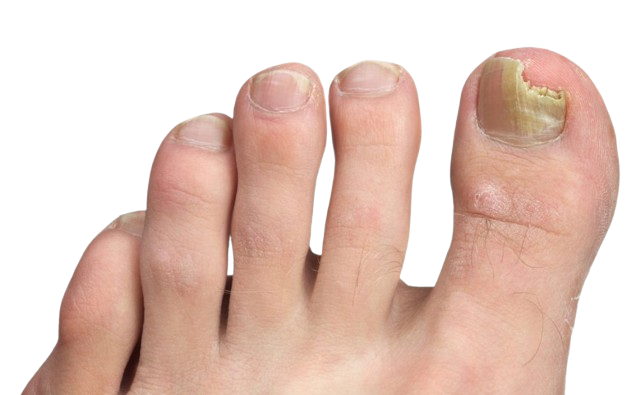
A cracked toenail is a common yet painful issue that can result from various injuries, such as stubbing your toe, dropping something heavy on it, or repetitive pressure from activities like running or hiking. While a minor crack may only cause discomfort, severe cases can lead to infection or further nail damage. Fortunately, there are several first-aid steps and treatment options to help manage and heal a cracked toenail effectively.
Understanding a Cracked Toenail
A cracked toenail occurs when the nail splits or breaks due to trauma or repeated stress. Depending on the severity, the crack may be superficial or extend deep into the nail bed. Some common causes include:
-
Direct Impact: A heavy object falling on the toe or accidentally hitting it against furniture.
-
Repetitive Pressure: Activities such as running, soccer, or tight-fitting shoes that place pressure on the toenail.
-
Weak or Brittle Nails: Underlying health conditions, vitamin deficiencies, or frequent exposure to moisture can make nails more prone to cracking.
-
Fungal Infections: Weakened nails due to fungal infections can crack easily under pressure.
Immediate First Aid for a Cracked Toenail
Taking quick action can help minimize pain and reduce the risk of complications. Follow these first-aid steps to address a cracked toenail:
1. Clean the Area
Gently rinse your toe with warm water and mild soap to remove any dirt or debris. This step helps prevent infection and allows for a clearer assessment of the damage.
2. Apply an Antiseptic
Using an antiseptic solution or hydrogen peroxide can help disinfect the area and reduce the risk of bacterial infection.
3. Stop Any Bleeding
If the nail crack has caused bleeding, apply gentle pressure with a clean cloth or sterile gauze until the bleeding stops.
4. Trim and File the Nail
If part of the nail is loose or jagged, carefully trim the affected portion using sterilized nail clippers. Use a nail file to smooth sharp edges to prevent further snagging.
5. Secure the Nail
For deeper cracks, you can use a small piece of adhesive bandage or medical tape to hold the nail together and protect it from further damage.
6. Apply a Protective Coating
Clear nail polish or a nail hardener can help reinforce the cracked nail and prevent it from worsening.
Treatment Options for a Cracked Toenail
After administering first aid, the next step is considering treatment options to promote healing and prevent future damage. Here are some effective treatments:
1. At-Home Care
-
Keep the Nail Clean and Dry: Regularly wash the toe and pat it dry to avoid moisture buildup, which can lead to infection.
-
Use a Toe Protector: A soft toe cap or bandage can protect the toenail from further trauma.
-
Apply a Moisturizing Nail Serum: Hydrating products containing biotin and keratin can strengthen the nail and prevent additional cracks.
2. Medical Treatment
If the cracked toenail is severe, seeking professional treatment is recommended. A podiatrist may suggest:
-
Trimming or Partial Removal: If the crack is deep, the doctor might trim the affected portion or remove part of the nail to promote healthy regrowth.
-
Antibiotics: If signs of infection appear, such as redness, swelling, or pus, a doctor may prescribe topical or oral antibiotics.
-
Nail Splinting: In some cases, a medical splint may be applied to keep the cracked nail intact while it heals.
3. Preventing Future Cracked Toenails
To avoid future injuries, consider these preventive measures:
-
Wear Proper Footwear: Ensure your shoes provide ample space for your toes and adequate support.
-
Keep Toenails Trimmed: Cutting your nails straight across and avoiding overly short trims can reduce the risk of cracking.
-
Strengthen Your Nails: A balanced diet rich in vitamins A, C, D, and biotin helps maintain strong, resilient nails.
-
Use Protective Gear: If you engage in high-impact activities, consider wearing toe guards or reinforced shoes.
When to Seek Professional Help
While minor cracks can heal with proper care, some cases require professional attention. You should visit a podiatrist if:
-
The nail crack extends deep into the nail bed.
-
You experience persistent pain or swelling.
-
There are signs of infection, such as redness, warmth, or pus.
-
The nail becomes detached or fails to grow back normally.
Treatment in Scottsdale
If you’re looking for expert care, you can find excellent treatment options for a Cracked Toenail in Scottsdale. Professional podiatrists can assess your condition and provide tailored treatments to promote quick and effective healing.
Conclusion
A cracked toenail due to injury can be painful and inconvenient, but with the right first aid and treatment approach, you can ensure a smooth recovery. Taking preventive steps, maintaining good nail health, and seeking professional care when necessary can help keep your toenails strong and healthy. If you’re dealing with a persistent or severe Cracked Toenail, consult a specialist to receive the best care and avoid complications.